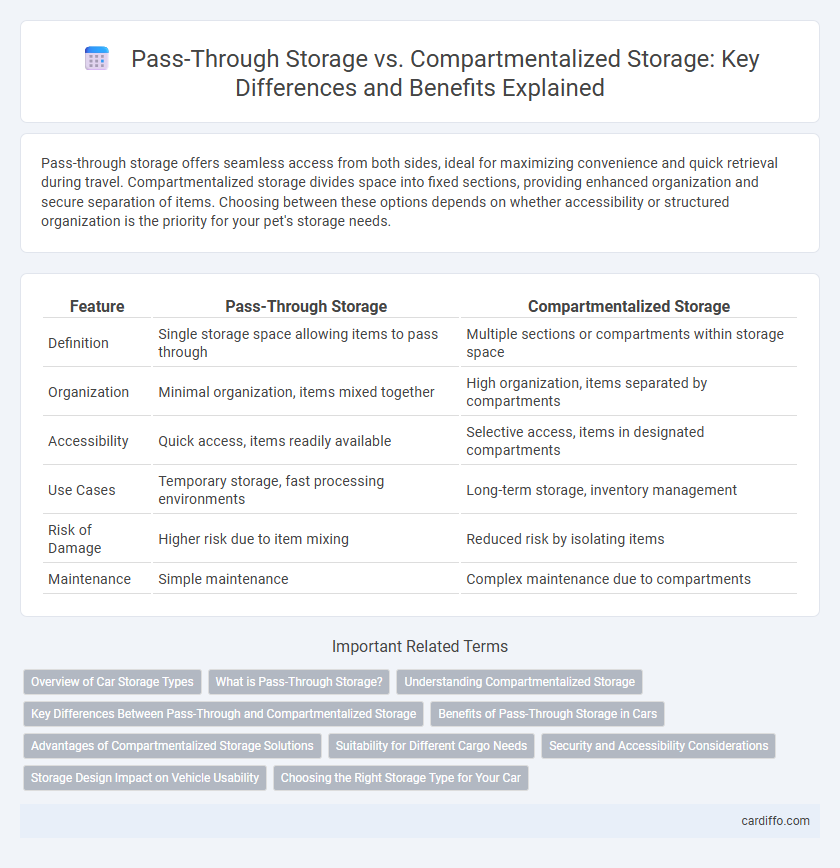Pass-through storage offers seamless access from both sides, ideal for maximizing convenience and quick retrieval during travel. Compartmentalized storage divides space into fixed sections, providing enhanced organization and secure separation of items. Choosing between these options depends on whether accessibility or structured organization is the priority for your pet's storage needs.
Table of Comparison
| Feature | Pass-Through Storage | Compartmentalized Storage |
|---|---|---|
| Definition | Single storage space allowing items to pass through | Multiple sections or compartments within storage space |
| Organization | Minimal organization, items mixed together | High organization, items separated by compartments |
| Accessibility | Quick access, items readily available | Selective access, items in designated compartments |
| Use Cases | Temporary storage, fast processing environments | Long-term storage, inventory management |
| Risk of Damage | Higher risk due to item mixing | Reduced risk by isolating items |
| Maintenance | Simple maintenance | Complex maintenance due to compartments |
Overview of Car Storage Types
Pass-through storage offers seamless access by allowing items to be stored and retrieved from either side of a vehicle compartment, enhancing convenience and space utilization. Compartmentalized storage divides the space into separate sections, promoting organization and security by keeping items isolated and protected. Both storage types cater to different needs, with pass-through favored for versatility and compartmentalized for orderliness in automotive designs.
What is Pass-Through Storage?
Pass-through storage refers to a data management approach where storage devices are directly accessible to virtual machines or applications without intermediary layers, enabling faster data transfer and reduced latency. This method bypasses traditional abstraction or virtualization layers, providing near-native performance by allowing direct read and write operations on physical storage hardware. Pass-through storage is commonly used in high-performance computing environments and databases requiring low latency and high throughput.
Understanding Compartmentalized Storage
Compartmentalized storage organizes data into distinct, isolated sections to enhance security, manageability, and performance by preventing overlap and unauthorized access between stored elements. This approach contrasts with pass-through storage, which allows direct access to storage media without segmentation, increasing the risk of data exposure and potential corruption. Implementing compartmentalized storage improves data integrity, supports compliance requirements, and optimizes resource allocation in complex storage infrastructures.
Key Differences Between Pass-Through and Compartmentalized Storage
Pass-through storage allows items to be accessed from multiple points without removing others, promoting ease of retrieval and efficiency in use. Compartmentalized storage divides space into distinct sections, enhancing organization and preventing cross-contamination between stored goods. The key differences lie in accessibility and organizational structure, with pass-through optimizing access flow and compartmentalized focusing on separation and order.
Benefits of Pass-Through Storage in Cars
Pass-through storage in cars maximizes cargo space by allowing longer items like skis or lumber to extend from the trunk into the cabin, enhancing versatility without compromising passenger comfort. This design improves accessibility, enabling easy loading and unloading of bulky objects through the rear seats, which fold down to create a continuous storage area. Pass-through storage also maintains organized compartmentalization while offering flexible configurations tailored to diverse travel needs.
Advantages of Compartmentalized Storage Solutions
Compartmentalized storage solutions enhance organization by segregating items into dedicated sections, reducing retrieval time and minimizing errors. This structured approach improves inventory management accuracy and prevents cross-contamination in sensitive environments. By optimizing space utilization, compartmentalized storage supports efficient workflow and scalability in complex operations.
Suitability for Different Cargo Needs
Pass-through storage offers seamless access and flexibility, ideal for bulky or irregularly shaped cargo that requires frequent retrieval, enhancing operational efficiency. Compartmentalized storage provides organized, segmented spaces suited for diverse or sensitive items, ensuring protection and minimizing cross-contamination. Selecting the appropriate storage type depends on cargo size, handling frequency, and security needs to optimize inventory management and transportation.
Security and Accessibility Considerations
Pass-through storage enables direct device access, enhancing data accessibility but posing higher security risks due to minimal isolation between systems. Compartmentalized storage employs strict boundaries and encryption, significantly improving data security by limiting unauthorized access while potentially reducing speed and flexibility. Organizations must balance the trade-offs, prioritizing stringent security protocols in sensitive environments versus streamlined accessibility in less critical scenarios.
Storage Design Impact on Vehicle Usability
Pass-through storage enhances vehicle usability by allowing longer items like skis or lumber to extend through the cabin, maximizing cargo space without sacrificing passenger comfort. Compartmentalized storage, by contrast, offers organized, separate sections that improve access and prevent items from shifting during transit but can limit the size of loadable objects. The choice between pass-through and compartmentalized designs directly influences cargo flexibility and interior space optimization in vehicle storage solutions.
Choosing the Right Storage Type for Your Car
Pass-through storage offers seamless access between compartments, maximizing space efficiency and ease of use for larger items in vehicles. Compartmentalized storage features distinct, separated sections that enhance organization and security for smaller valuables during transit. Selecting the right storage type depends on balancing accessibility needs with protection requirements for your automotive cargo.
pass-through storage vs compartmentalized storage Infographic

 cardiffo.com
cardiffo.com